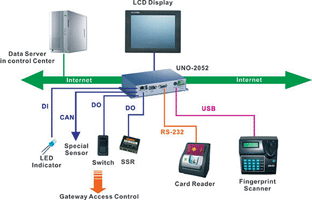
To meet the challenges of ever-increasing passenger traffic through customs, more and more countries are choosing to employ the automated passenger clearance system (APCS). In Hong Kong, the government decided to upgrade its existing system as well, dubbing their APCS the 'E-Channel'. With Advantech's UNO-2052 Universal Network Controller, all devices are integrated in an open architecture.
System requirements
More than 400 000 people pass through customs in Hong Kong every day. At the Luohu checkpoint, each traveller is given about one minute to be identified. Since Hong Kong is one of the most popular tourist and business destinations in Asia, not to mention a major trading and transportation hub, customs officials must constantly review procedures and explore ways to allow passenger clearance to run more efficiently.

Their latest effort is an APCS project called the 'E-Channel', which incorporates many new technologies such as: biometrics, smartcards, wireless functionality, and embedded PCs. They hope this system can reach an 8-12 seconds per person processing time. Based on their requests, the system required the following specific parameters:
* Compact size.
* USB port support for the fingerprint scanner.
* CAN port support for special sensors.
* COM port support for communication with the card readers.
* LAN support for an Internet connection.
* Economic price.
* Stability and reliability.
Project implementation
Advantech's UNO-2052 Universal Network Controller: with GX1-300 UNO with two x CAN, LAN, USB, RS232, eight x isolated digital I/O, two x analog inputs.
The UNO-2052 works as a central controller to integrate multiple devices. It is connected to a fingerprint scanner via USB, smartcard readers through an RS232, gateway access control, an LED indicator via CAN and DI/Os, and a central data server through LAN.
The E-Channel's processing system is simple: first people walk up to the card reader unit, and insert their Smart Identity Cards. The system will then connect to the central data server to get identity approval through the Internet. While getting approval, it will notify the gate doors to open, and people can enter the E-Channel. After entering, people place their thumbs flat on the centre of the scanner for fingerprint analysis. After verification, the gate doors will open and they can leave. Only one person is allowed to enter the E-Channel at a time. While one person is going through the fingerprint verification, the next person in the queue may insert their Smart Identity Card into the reader. In the event of an error or accident, the system can send out a warning message to customs personnel through wireless communication
Conclusion
UNO-2052 is the perfect controller for this complex system. Its compact size can fit into the limited space, and fanless design provides high reliability and stability for continuous operation. Compared to other PLCs, the UNO-2052 provides open architecture for easy integration with other devices and popular software such as Windows CE. Furthermore, it offers rich communication interfaces such as CAN, DI/O, serial port, and USB ports to easily connect to other devices. Advantech works closely with this customer to provide local technical support. Now, the process time through Hong Kong customs has been shortened to 8-12 seconds per person, providing customers and travellers alike with more efficient and speedy processing.
| Tel: | +27 12 666 9066/8 |
| Email: | [email protected] |
| www: | www.cme.co.za |
| Articles: | More information and articles about Centurion Micro Electronics |

© Technews Publishing (Pty) Ltd | All Rights Reserved